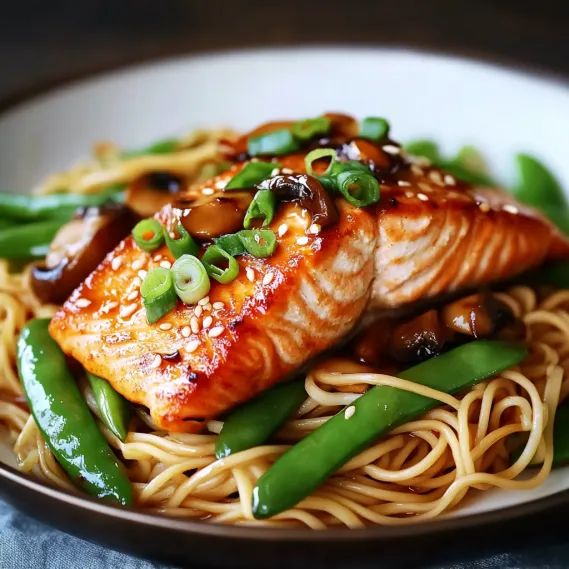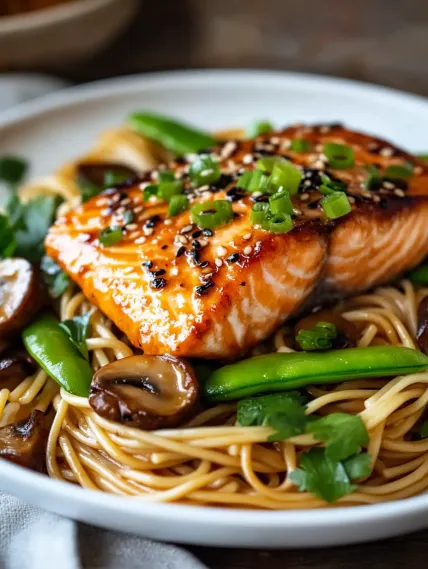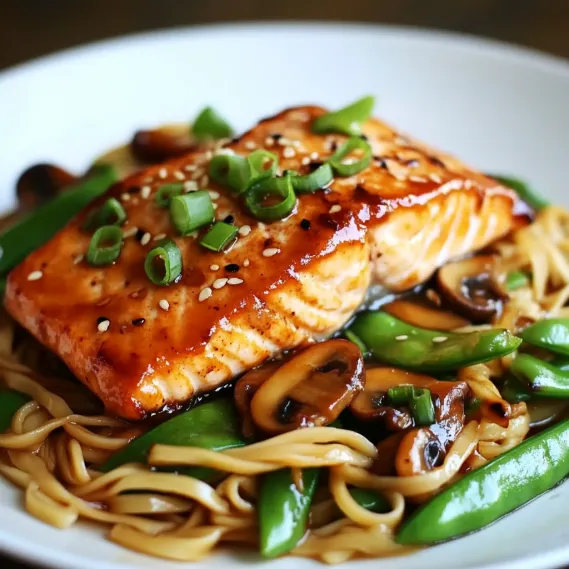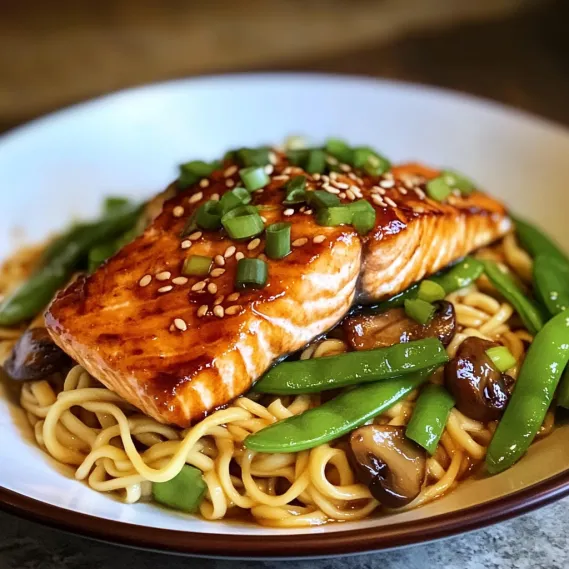 Pin
Pin
Indulge in a harmonious blend of sweet and spicy flavors with this Asian Salmon and Noodles dish. The succulent salmon, glazed to perfection with honey and soy sauce, pairs exquisitely with Sriracha-infused noodles filled with mushrooms and crisp snow peas. This fusion dish brings together the best of Asian-inspired flavors in a meal that's surprisingly simple to prepare yet tastes like something from your favorite restaurant.
I discovered this recipe during a month when I was trying to incorporate more fish into our family meals. My husband had always been skeptical about salmon, claiming it was 'too fishy,' but the sweet glaze and complementary noodles in this dish completely won him over. Now he requests it regularly, which feels like a major culinary victory in our household.
Essential Ingredients and Selection Tips
- Salmon Fillets: Look for center-cut pieces of equal thickness for even cooking. Wild-caught offers superior flavor, but farm-raised works well too.
- Soy Sauce: Use low-sodium if you're watching salt intake. For gluten-free options, tamari makes an excellent substitute.
- Honey: Local honey offers subtle flavor variations that can enhance the dish. The natural sweetness balances the salty soy sauce perfectly.
- Sriracha: Adds the perfect heat without overwhelming the other flavors. Start with less if you're sensitive to spice.
- Snow Peas: Choose bright green, plump pods. They should snap crisply when bent, indicating freshness.
I've found that splurging on high-quality sesame oil makes a noticeable difference in this dish. The nutty, aromatic qualities of a good sesame oil elevate the entire sauce and create that authentic Asian restaurant flavor that makes this recipe special.
Detailed Cooking Instructions
- Step 1: Prepare the Noodle Base
- Heat olive oil in a large frying pan over medium heat. Add chopped green onions and sesame seeds, sautéing for 2 minutes until fragrant but not browned. This builds the aromatic foundation for your noodles.
- Step 2: Build the Savory Sauce
- Add sliced mushrooms to the pan and cook for another 2 minutes until they begin to brown. Pour in soy sauce, honey, chicken stock, sesame oil, and Sriracha, stirring to combine. Simmer gently to intensify flavors.
- Step 3: Prepare the Vegetable Components
- Cook snow peas in boiling water for about 5 minutes until bright green and tender-crisp. Cook fettuccine according to package directions until al dente. Combine both with the sauce, tossing gently to coat evenly.
- Step 4: Master the Salmon
- Preheat your broiler. Lightly coat salmon fillets with olive oil, salt, and pepper. Place them on the broiler, flesh-side down, for about 4 minutes until golden brown and slightly charred. Flip carefully and set aside.
- Step 5: Create a Harmonious Glaze
- Mix honey and soy sauce in a small bowl until the honey dissolves completely. This balanced mixture creates depth without overwhelming heat.
- Step 6: Finish with the Perfect Glaze
- Flip the salmon and brush with the honey-soy mixture. Transfer to broiler for approximately 4 minutes until the glaze caramelizes slightly. Remove from heat and let rest briefly before serving over the prepared noodles.
- Step 7: Serve Immediately
- Transfer the glazed salmon to a serving platter and spoon the sauce generously over the noodles. Garnish with fresh chopped parsley and serve immediately for maximum flavor impact.

I learned the importance of properly searing salmon after my first attempt resulted in overcooked, rubbery salmon. The difference between perfect and overdone is literally a matter of seconds. The key breakthrough came when I started using the broiler to finish the salmon, creating that perfect balance of crisp exterior and tender, juicy interior.

The Art of Perfect Noodles
The true art of noodle-making lies in the lamination technique that creates those beautiful, distinct layers. When I first started making these, my layers would often disappear during frying, resulting in something closer to a regular noodle. I learned that patience during the folding and chilling cycles is absolutely critical. Each time the dough rests in the refrigerator, the gluten relaxes while the butter firms up just enough to maintain separation between the layers. My breakthrough came when I started using a ruler to ensure even rolling and precise folds. Now when I slice into a finished noodle, I'm rewarded with that gorgeous honeycomb structure that signals perfect lamination.
Perfect Filling Balance
Finding the right balance between the vanilla bean pastry cream and strawberry jam took several attempts to perfect. Initially, I used too much jam, which overwhelmed the delicate vanilla notes and made the noodles soggy within hours. Through trial and error, I discovered that piping a generous ring of vanilla bean pastry cream first creates a stable foundation, with just a small dollop of jam in the center. This approach highlights both flavors while maintaining the structural integrity.
Temperature Management Mastery
Maintaining proper temperature throughout the process transforms good noodles into exceptional ones. During my early attempts, I worked in a warm kitchen and constantly fought melting butter that leaked during lamination. Now I keep a digital thermometer nearby to monitor both the dough and my workspace. I've found that chilling the rolling pin and work surface before each rolling session helps tremendously during summer months. For frying, I use a deep-fry thermometer and adjust the heat constantly to keep the oil between 345°F and 355°F. This narrow temperature range ensures the noodles puff dramatically while cooking through perfectly without burning.
Seasonal Inspiration
While the strawberry-vanilla combination remains our family favorite, I've created seasonal variations that showcase the versatility of this technique. During autumn, I substitute apple butter and cinnamon pastry cream, rolling the finished noodles in maple sugar. For Christmas morning, a chocolate pastry cream with peppermint-scented sugar creates a festive holiday treat. The spring version featuring lemon curd and blueberry jam has become particularly popular with friends, who request it for brunch gatherings when berries are at their peak.
Make-Ahead and Freezer Tips
For busy households, this recipe shines as a prepare-ahead solution. The noodle squares can be made up to twelve hours before baking, storing in an airtight container in the refrigerator. The glaze can be prepared a day ahead and gently reheated before using. For longer storage, freeze the noodle squares for up to a month. Thaw overnight in the refrigerator before glazing as directed, adding 1-2 minutes to the glazing time.
Chef's Essential Tips
- For extra flavor, add a teaspoon of dried thyme or rosemary to the mushroom mixture
- Toast the potato chips lightly before using for added crispiness
- Add a pinch of cayenne pepper to the mushroom mixture for a spicy kick
- For a thicker sauce, mix 1 tablespoon cornstarch with 2 tablespoons cold water and stir into the sauce during the last 5 minutes
- The dish keeps well for leftovers and tastes even better the next day
I discovered these refinements over many iterations of this dish - particularly the addition of rosemary, which adds remarkable depth to the flavor profile without being identifiable as rosemary.
This versatile strawberry vanilla bean pastry cream noodle recipe has become my reliable go-to when I need a satisfying meal that pleases everyone. The combination of tender pasta, bright fruit flavor, and creamy filling creates something greater than the sum of its parts - a dish that feels indulgent while being surprisingly simple to prepare.

This Strawberry Vanilla Bean Pastry Cream Noodle recipe proves that adventurous flavor combinations can still feel approachable when presented in a familiar format - opening up new possibilities for creativity in your noodle repertoire.
Recipe FAQs
- → Can I use a different type of pasta?
- Yes, you can substitute fettuccine with other pasta types like spaghetti, linguine, or even rice noodles for a more authentic Asian flavor. Just adjust cooking times according to package instructions.
- → How do I know when the salmon is cooked properly?
- Salmon is cooked when it flakes easily with a fork and reaches an internal temperature of 145°F (63°C). The center should be opaque but still moist. Be careful not to overcook, as salmon can dry out quickly.
- → Can I make this dish less spicy?
- Absolutely! You can reduce or omit the Sriracha sauce if you prefer less heat. The honey and soy sauce will still provide plenty of flavor without the spice.
- → What can I substitute for snow peas?
- If snow peas aren't available, sugar snap peas, green beans, or broccoli florets make excellent substitutes. Just adjust cooking times accordingly as denser vegetables may need a bit longer to become tender.
- → Can I prep any components of this dish ahead of time?
- Yes! You can slice the mushrooms, chop the green onions, and mix the salmon glaze up to a day in advance. You could also cook the pasta ahead of time, toss it with a little oil to prevent sticking, and refrigerate until needed.
